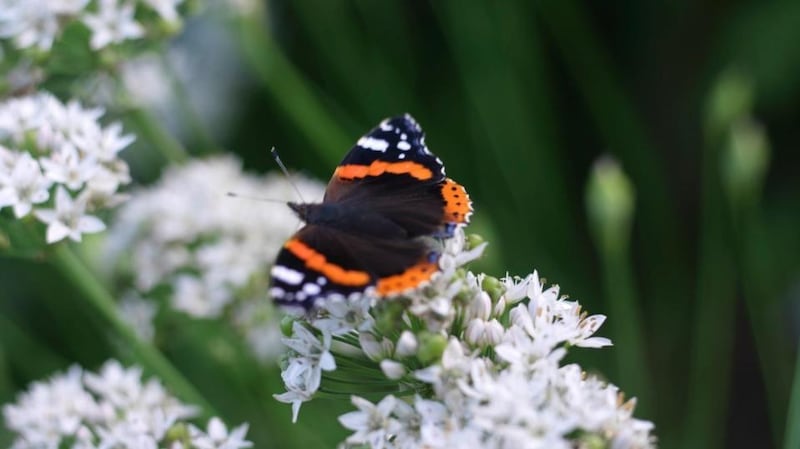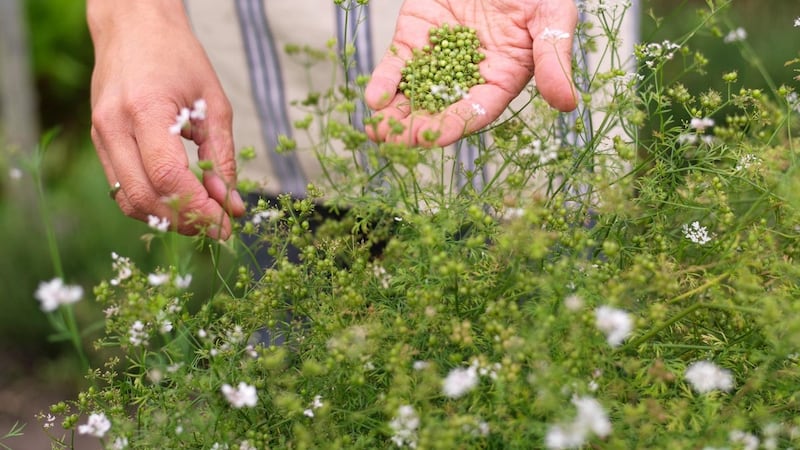Ask any seasoned kitchen gardener pressed for time and growing space to name a group of plants that combine impressive productivity and general all-round usefulness with ease of cultivation and you can be pretty sure that culinary herbs will come top of their list. Parsley, sage, coriander, mint, thyme, rosemary, tarragon, chives, chervil, summer savory, dill, fennel, lemon verbena and marjoram: all will grow quite happily in either a pot or window box with the minimum amount of fuss and bother, saving you the hassle, inconvenience and expense of having to buy them in a supermarket.
In addition, there’s that great peace of mind that comes from knowing that your homegrown herbs will be organically grown, chemical-free, planet-friendly and brimful of freshness and flavour.

May is an excellent time of the year to create this sort of miniature herb patch as both the hardy, longer-lived perennial and biennial kinds as well as the short-lived, frost-hardy annual types are available to buy as affordable young plants from good garden centres. Some can also be easily raised from seed. But first a few tips on getting the very best results.
As a general rule, culinary herbs can be roughly divided into three categories in terms of the growing conditions that they require. Some, such as rosemary, thyme and oregano/marjoram, are dedicated sun-lovers that typically require a very bright, warm, sheltered position and a free-draining (not the same as bone-dry) neutral to alkaline soil to thrive. Basil is especially fussy in this regard, with the result that it must be grown indoors in a warm, very bright, draught-free room. These sorts of intense-light and high-heat conditions also help sun-loving herbs to fully develop the complex flavours and aromas that are such an important part of their culinary charm.
But other popular herbs – examples include mint, parsley, coriander, chervil and sweet woodruff – are happiest in light shade and a cooler, more moisture-retentive growing medium where their roots won’t dry out. And then there are the in-betweeners such as chives, French tarragon, bay, sage, summer savory and dill that will grow quite happily in either light shade or full sun as long as you give them a moisture-retentive but free-draining soil.
For this reason, it makes a lot of sense to create two small herb patches, one situated in the sunniest, most sheltered spot in the garden (typically a south or west-facing outdoor window sill or patio) and the other in an area where the plants will be in light or dappled shade. You don’t, of course, have to have a dedicated herb patch – many will grow quite happily popped into the flower border or vegetable patch – but it does make harvesting an awful lot easier. For the same reason, your herbs should be grown in an easily accessible spot, ideally close to the house, because no one really wants to traipse the full length of the garden on a wet day just to pick some parsley.
Growing medium
Also take care when it comes to creating the ideal growing medium. If you’re growing herbs in containers, make sure to use a soil-based John Innes compost rather than peat and add plenty of coarse horticultural grit (available from most good garden centres) for the heat-loving kinds to further improve drainage and prevent their sensitive root systems from water damage.
Bear in mind that the sun-loving, mat-forming thymes hate cramped growing conditions and thus are best given their own living quarters. So ideally grow these in their own individual unglazed terracotta pots or in old shallow stone troughs as these sorts of naturally porous/breathable materials provide the extra summer warmth and sharp drainage that they require. Likewise, tall, deep-rooted herbs such as fennel, dill, lovage, sweet cicely and lemon verbena aren’t suitable for shallow window boxes and instead need to be planted in the ground or into large deep pots to prosper. Other culinary herbs – examples include mint and lemon balm – are also best grown in containers because of their invasive tendencies when let loose in the garden.
As mentioned earlier, now is an excellent time to raise some herbs from seed, especially the fast-growing annual and biennial kinds such as chervil, parsley, coriander (directly sow this to discourage it from bolting) and dill (also best direct sown). But most of the longer-lived perennial or shrubby kinds (examples include rosemary, thyme, sage, lemon verbena and sweet cicely) are more easily bought as young plants or raised from cuttings or divisions as they can be slow and unreliable when it comes to germination.

Recommended Irish organic seed suppliers include Cork-based organic seed producer Brown Envelope Seeds (brownenvelopeseeds.com), Dublin-based The Herb Garden (theherbgarden.ie) and Galway-based Seedaholic (seedaholic.com), while specialist online suppliers of organically-grown herb plants include west Cork-based Peppermint Farm (peppermintfarm.com).
Whichever herbs you plump for, all will benefit from regular light picking as well as a fortnightly liquid seaweed feed during the growing season to keep them in bonny good health. When it comes to harvesting, do your very best to pick evenly from each plant and avoid cutting into old wood when it comes to the shrubby evergreen kinds. But do give the shrubby and perennial kinds a general tidy-up in spring by cutting away dead stems.
After that, it’s a case of savouring the pleasure and abundance of having your own homegrown herbs on tap. Make mint-flavoured mojitos. Sweet cicely shortbread. Lemon verbena flavoured sorbets and puddings. Relish the taste of roast potatoes sprinkled with homegrown rosemary, chervil-flavoured butter, and curries soaked in the flavours of homegrown basil and coriander. All of it from a few window boxes and pots. What more could you ask for?
This week in the garden
If you directly sowed seed of vegetables such as beetroot, parsnips, carrots, turnips, spinach and lettuce in the garden or allotment in the last few weeks, then the lines of young seedlings should be emerging. To give these crops sufficient room to develop, it’s important to thin the young seedlings out to the correct spacing before they get overcrowded. Handled very gently (using the tip of a trowel to tease the roots undamaged out of the soil and holding the seedlings by their leaves), the thinned seedling can also be quickly transplanted elsewhere if and when required, the only exception being vegetables with long tap roots such as carrots or parsnips. Always gently water seedlings immediately after thinning or transplanting and make sure to protect them against snails and slugs.
Start hardening off young tender bedding plants such as dahlias, cannas, argyranthemums, begonias and petunias, and frost-tender vegetables such as courgettes, pumpkins and sweetcorn, over the next fortnight to slowly acclimatise them to the tougher growing conditions that they’ll face once growing outdoors. This should be a gradual process to avoid shocking the young plants and slowing or even temporarily checking/halting their growth. With glasshouse/polytunnel-grown plants, start placing plants outdoors during any bright or sunny days, while making sure to move them back before nightfall. Recently purchased bedding bedding plants will also need to be hardened off in the same way to protect them from damage.
If you grow a lot of shrubby or perennial plants in pots, then now is a great time to top-dress them to ensure plenty of healthy growth and a good display over the coming months. This is a very simple and straightforward process: just gently scrape away the top 3cm of stale compost and replace it with a fresh layer of good-quality compost plus a light sprinkling of slow-release, soft-acting organic fertiliser in granular or pelleted form. If you suspect that a container-grown plant has become pot-bound – obvious signs include poor growth and its roots pushing through the container’s drainage holes- then now is also a good time to pot it on into a larger container. Again, make sure to use a fresh, good-quality compost and a sprinkling of slow-release, soft-acting organic fertiliser and to water well after you’ve finished.
Dates for your diary
Saturday: Maynooth Community Space (beside Range store), Maynooth, Co Kildare, Maynooth flower and garden plant sale (2pm-5pm), see maynoothflowerandgardenclub.com.
Sunday: at Burtown house and gardens, Athy, Co Kildare – Rare and Special Plant Fair 2018 (from 10am), with more than 40 specialist nursery stands of rare and unusual plants and expert advice from growers. See burtownhouse.ie.
Thursday: "Fuchsias," a talk by fuchsia expert and horticultural judge Nick Egan on behalf of Dublin 5 Horticultural Society at the Artane Beaumont family recreation centre, Kilmore Road, Artane. Admission: €5.
Saturday, May 19th: garden owner Frank Lavery will be opening his private garden at 30 Ailesbury Drive, Dublin 4, to the public with all proceeds in aid of Blackrock Hospice (2pm-5pm). Admission €5 (garden not accessible to wheelchair users).
Sunday, May 20th: RHSI garden, Russborough House, Blessington, Co Wicklow, garden open day (2-5pm), see rhsi.ie. Mount Congreve plant fair, Mount Congreve Gardens, Co Waterford (11am-5.30pm), see mountcongreve.com.
Tuesday, May 22nd: Foxrock parish pastoral centre, 18 Kill Lane, Dublin 18 – "Essential Plants for a Good Garden," a talk by UK-based hardy plants nursery owner Kevin Hughes on behalf of Foxrock Garden Club (8pm).











